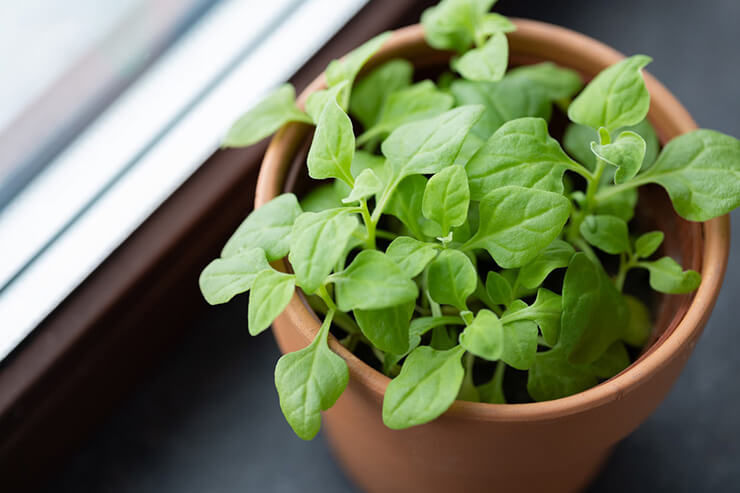Spinach (Spinacia oleracea) is one of the most nutrient-packed greens you can grow, and thankfully, it’s also one of the easiest to raise indoors. Quick to sprout, modest in its needs, and endlessly useful in the kitchen, spinach is a favorite for beginner and seasoned indoor gardeners alike. With its vibrant green leaves and tender texture, spinach adds freshness and nutrition to salads, smoothies, stir-fries, and soups.
The best part? You don’t need a backyard to enjoy a steady harvest of spinach. Grown in containers on a windowsill or under grow lights, spinach can thrive year-round—providing cut-and-come-again harvests in as little as 3 to 4 weeks. By choosing varieties suited to small spaces, cool temps, and repeated harvests, you can enjoy a steady supply of fresh spinach without ever stepping outside.

Soil and pH Preferences
Like most leafy greens, spinach does best in fertile, moisture-retentive soil that drains well and supports quick vegetative growth.
- Soil pH:Spinach prefers a pH range between 2 and 7.0—slightly acidic to neutral is ideal.
- Soil Texture:Use a light, well-draining potting mix with organic matter. A blend of peat moss or coco coir, perlite, and compost works well.
- Fertilizing:Before planting, amend with a balanced organic fertilizer. Once leaves start forming, a mild liquid feed every 10-14 days can keep them lush and flavorful.
Light Needs
Spinach enjoys light, but not too much heat. Indoors, providing enough light without overheating is key.
- Daily Light Requirement:Aim for 10 to 14 hours of light each day for optimal leaf production.
- Grow Lights:Spinach thrives under full-spectrum LED or fluorescent grow lights. Position the lights about 6 inches above the foliage and raise them as the plants grow.
- Natural Light:A bright east- or south-facing window will do nicely during cooler months. If you’re in a warm climate, a shaded window may actually prevent bolting (premature flowering).
Watering Guidelines
Even moisture is essential for growing soft, tender spinach leaves. Too little water results in slow growth and bitter leaves, while overwatering can lead to root rot.
- Watering Schedule:Keep soil evenly moist, but not soggy. Water when the top half-inch of soil feels dry.
- Watering Tips:Bottom watering (placing pots in a shallow tray of water) encourages deep root growth and avoids wetting the foliage, which can lead to mildew.
- Humidity:Spinach is adaptable to average household humidity levels (around 40-60%), but good air circulation helps prevent fungal issues.
Ideal Indoor Growing Setup
Spinach isn’t fussy—but it does prefer consistency. With the right tools and timing, you can grow lush spinach nearly anywhere indoors.
- Container Depth:Choose pots at least 6 inches deep. Wide trays or planters work well since spinach doesn’t need much space per plant.
- Temperature Range:Cool temps between 55-70°F (13-21°C) are best. Avoid warm, dry spots near radiators or heat vents.
- Spacing:Thin plants to 3-4 inches apart once seedlings emerge to ensure good airflow and leaf development.
- Growth Cycle:Most varieties are ready for harvesting baby leaves in 3-4 weeks, with mature leaves in 5-6 weeks.
Spinach Variety Showcase: 5 Great Choices for Indoors
Spinach is an indoor gardener’s best friend: quick to grow, easy to harvest, and endlessly useful in the kitchen. Whether you’re snipping baby leaves for a morning smoothie or gathering a full bowl of greens for dinner, spinach offers a satisfying return on your indoor gardening efforts.
By choosing varieties suited to small spaces, cool temps, and repeated harvests, you can enjoy a steady supply of fresh spinach without ever stepping outside.
Baby’s Leaf
Developed specifically for baby greens, Baby’s Leaf spinach is perfect for shallow trays and quick harvests. It stays compact, making it excellent for tight growing spaces.
Indoor Perks:
- Short, fast growth cycle (25-30 days)
- Ideal for harvesting young, tender leaves
- Works beautifully in hydroponic or soil-based setups
Common Uses:
- Fresh salads and wraps
- Added to smoothies for a mild green boost
- Tossed into pasta or risotto at the last minute for a fresh burst of flavor
Bloomsdale Long Standing
This heirloom variety is a classic for good reason. With thick, crinkled leaves and rich flavor, Bloomsdale stands up well to cooking and is slow to bolt.
Indoor Perks:
- Dense, flavorful leaves, even in cooler temps
- Slightly more tolerant of warmth than other heirlooms
- Great for deeper containers with strong root support
Common Uses:
- Sautéed with garlic or olive oil
- Folded into frittatas or casseroles
- Blended into hearty soups or stews
Space
Space is a hybrid spinach variety known for its smooth, upright leaves and bolt resistance. It grows quickly and evenly, making it a go-to choice for indoor gardeners looking for reliability.
Indoor Perks:
- Excellent resistance to downy mildew and heat
- Smooth leaves are easy to clean and harvest
- Tolerates lower humidity levels well
Common Uses:
- Base for power bowls or grain salads
- Layered into sandwiches or flatbreads
- Steamed and served with lemon or tahini
Tyee
This semi-savoy (slightly crinkled) variety is a great middle ground between tender baby greens and sturdier cooking spinach. Tyee is well-regarded for its resilience and strong yields indoors.
Indoor Perks:
- Slow to bolt under artificial lighting
- Thrives in both soil and hydroponic systems
- Excellent for continuous harvesting
Common Uses:
- Cooked into egg dishes or savory pies
- Added to bean and lentil dishes for extra greens
- Freezes well (in small batches) for future use
Red Kitten
A newer addition to the spinach scene, Red Kitten has striking deep green leaves with red veins and stems. It’s tender, fast-growing, and adds flair to any garden or salad bowl.
Indoor Perks:
- Visually appealing and nutrient-rich
- Grows well in cooler conditions
- Perfect for harvesting as baby greens
Common Uses:
- Mixed into salad blends for a pop of color
- Juiced with fruits and herbs
- Used fresh as a garnish for soups and appetizers


 Previous
Previous

